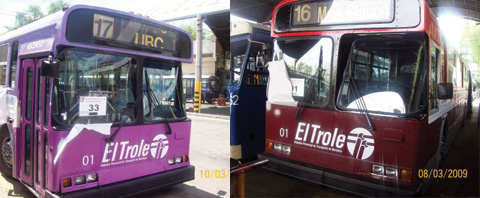Retired trolleys in purple and red!
Retired trolleys in purple and red!
Just wanted to point out another post from Jorge Luis Guevara: it shows two trolleys in purple and red paint schemes, in their new home in Mendoza, Argentina. How lovely!
And as always, here are the past posts on the retired trolleys in their new home:
- Retired trolleys get a new look in Argentina
- Video of the retired trolleybuses on the streets of Mendoza
- Two more photos of the retired trolleys off to Argentina
- The retired trolleys on Argentinian TV!
- Retired trolleys make their way to Mendoza
- The retired trolleys arrive in Chile!
- The trolleys of Mendoza, Argentina
- Update on the retired trolleys sailing to South America
- Retired trolleys set sail for Argentina







Tell me again why we got rid of these trolleys? Im being sarcastic about that comment. I really don’t understand why we didn’t use those trolleys as rush hour “tripper” I really miss these trolleys as the E900 worked alot better during rush hour and in the snow and cold hold many more people and had less people sneaking through the rear doors. That is my 2 cents
Hi Dan,
As mentioned in the very first article on the retired trolleys, we retired them since they were not accessible to those with mobility issues: the buses all had high floors and poles in the middle of the doorways. As well, after 25 years, the trolleys had endured extensive wear and tear that cost too much to fix and maintain. These Flyer trolleys had each seen about 1.2 million kilometres on the road.
I wonder why El Trole didn’t install new headsigns. If you’re going to give them a new paint job, you might as well do something utilitarian like fixing your destination headsigns right-off the bat. But then again, it seems as if they use placards in the front right window instead of headsigns. Does anyone know if that is what the “33” in the left-hand picture is? If not, what’s the significance of those placards? I’ve seen placards in the pictures or regular in-service vehicles, too.
@ other Dan: you’d probably find it interesting, and possibly ironic, that Calgary purchased 20 year-old East German railway carriages to use for the C-Train when they first implemented the service. Most of them are still in regular use.
The placards were shipping numbers actually — I saw them on the buses when they were on the dock. They might have left them on just so they can keep track of which bus is which.
It also really puzzles me why we have to make the whole system accessible. When the majority of the people who use the wheelchair lift or ramp never pay their fare. And maybe we can start with the 3 Main, 20 Victoria, 8 Fraser, 135 SFU/Burrard Stn. 701 Coq Stn/Haney Place. Just to name a few. I remember when i was little and it was NEVER EVER a problem is folding up the stroller before boarding. It worked. People respected the seating priority. There is no need for every bus to be 100% accessible like on a school tripper or like a busy skytrain breakdown and they need a bus bridge. I kinda wonder why there is handyDART when the disabled complain about that. The other thing that concerns me that older people demand to use a lift on a conventional high floor and they have a walker but they fold it up and get on no problem on a Community Shuttle. Same with some of the strollers and even Wheelchairs! Keep the older buses they can be used for many years of service as they are all across North America & the world. That is my rant
Dan:
Public transportation is for the public, and that includes those with mobility issues. As our Access Transit program indicates, “TransLink needs to ensure that the region has a transit system as accessible as possible to the greatest number of people, recognizing the physical, cognitive or other difficulties they may have in getting around.”
If you are interested in finding out more about these issues, you can read more about our plans for transit accessibility at the Access Transit website.
Dan – the Canadian Charter does not acept any kind of discrimination, so we have an obligation to remove barriers to people with impairments and mobility issues. It’s the same reason why public buildings must have ramps and wheelchair washrooms, to mention just two. The same reason the buses trains are required to announce the stops (for the blind) or provide visual stop information (for the deaf). The population is aging. The low floor buses make it easier for people with strollers and those who have trouble with stairs to access the bus. There’s going to be a lot more of them over the coming years.
Dan B – my guess on the roller blinds is that they are impossible to find or extremely costly to manufacture. Most systems use digital signs now.
This gives me the best idea for an April Fool’s Day prank.
ps/
By default, my name and email in the boxes above the comment box are Dan’s data.
Thanks Scott — that commenting thing is a known issue and the web staff is working on solving it.
Just did a bit of forensic work based on old photos…
The purple bus is 2806, the red one is 2703.